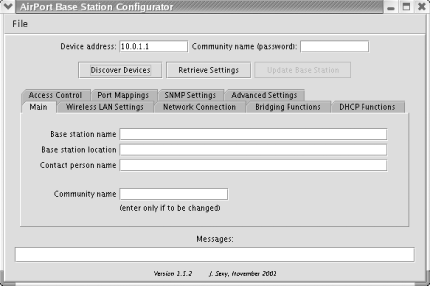5.3 Configuring Access Points
| < Day Day Up > |
| While many of the manufacturers we've covered allow their wireless equipment to be configured through a web or telnet interface, this is not an option for Orinoco or Apple access points. However, there are two options for configuring Orinoco access points under Linux and at least one option for Apple AirPort configuration. 5.3.1 Orinoco CLI ProxyOrinoco provides a program it calls the CLI Proxy. It's available at http://www.proxim.com/support/all/orinoco/software/dl2002_orinoco_apcli_117_linux.html. If you look at the accompanying README file, there appears to be support from Orinoco for this product. The release notes and program are from 2002 and have not been updated in a while. The system requirements state that the program runs under Red Hat Linux 6.1 or similar systems. We were able to successfully install and run the package on both Red Hat 9 and Debian Woody distributions. To install the CLI Proxy, download the .tgz file from the Orinoco web site. The help notes suggest unpacking it in the /opt directory, but that's not necessary. The package can be unpacked in any location that makes sense for your filesystem. For our purposes, we'll assume you're using /opt . You'll need 1.5 MB of disk space for installation. To unpack, execute the following command as root: tar xzvf clili117.tar.gz The package is a compiled binary with no source, so at this point all you can do is execute the program with the command /opt/cliproxy/cliproxy . You'll see this prompt: [CLI]> First, read through the HTML documentation that is installed with the program in the /opt/cliproxy/Help directory. The program works by downloading a configuration from an Orinoco access point on your local subnet. The program makes use of broadcast traffic, so your Linux box must be on the same physical network as the access point for it to work. You can also open a local configuration file. This is done through the use of the configure command. Saving the file is accomplished by writing the file to disk or writing it to the access point, and is done by issuing the command write . The interface is very similar to Cisco IOS, along with tab-completion of commands and the use of the ? key to find context sensitive help. For example, show ? gives you all of the options to the show command. Once you have opened a configuration for editing, you can modify any of the access point features available, from the wireless interface to TCP/IP options to setting up bridging. The Orinoco access points have a pretty broad set of features. The software ships with default configuration files for the Orinoco AP-1000 and AP-500, which you can open and modify to fit your needs. 5.3.2 Airport/RG-1000 ConfiguratorJon Sevy of Drexel University has built a Java-based configuration program for the Apple AirPort and the Orinoco RG-1000 access point. He also has versions of this program for the newer AirPort models with two Ethernet ports and the AirPort Extreme 802.11g model. The software can be downloaded from http://edge.mcs.drexel.edu/GICL/people/sevy/airport/#Configurator. There are versions for Unix as well as MacOS 9, Mac OS X, and Windows. You need a Java 1.2-compliant runtime engine (JRE). The latest versions of Java for many platforms can be downloaded from Sun Microsystems at http://java.sun.com/j2se/1.4. Once you've downloaded the Configurator, unpack it in a directory of your choice and run the program using this command line: java -jar AirportConfigurator.jar When Java starts, it executes the Java Archive (JAR) code, which will result in Figure 5-3. Figure 5-3. Java AirPort/RG-1000 Configurator main screen If you're familiar with either the Orinoco configuration programs available for Windows or the FreeBase configuration software written to configure an Apple AirPort from Windows, this screen is very familiar. As you can see, you have the option to discover compatible devices on your network or to specify the IP address of a device you wish to configure. Configuration is handled through a series of tabs, giving you options for wireless and wired network settings, bridging, DHCP, and a whole host of advanced settings. |
| < Day Day Up > |
EAN: 2147483647
Pages: 100